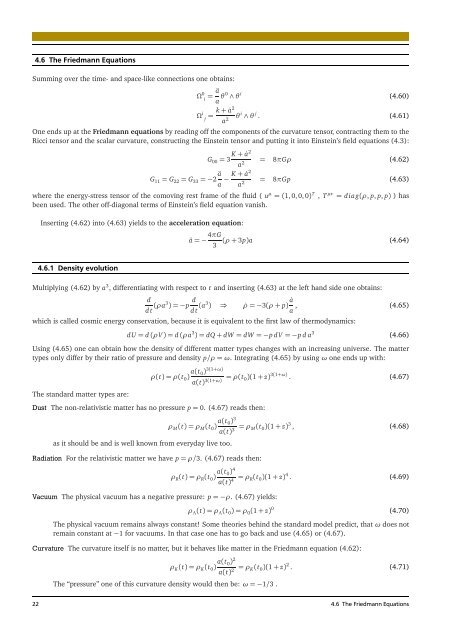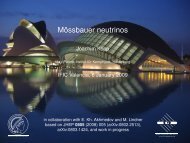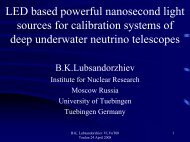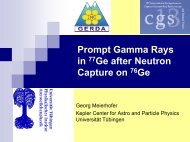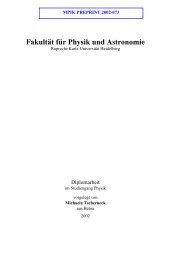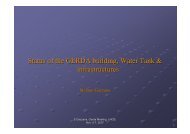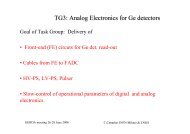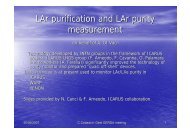Master Thesis
Master Thesis
Master Thesis
Create successful ePaper yourself
Turn your PDF publications into a flip-book with our unique Google optimized e-Paper software.
4.6 The FriedmannEquations<br />
Summing over the time- and space-like connections one obtains:<br />
Ω 0 ä<br />
i =<br />
a θ 0 ∧θ i<br />
(4.60)<br />
Ω i k+ ˙a2<br />
j =<br />
a2 θ i ∧θ j . (4.61)<br />
One ends up at the Friedmann equations by reading off the components of the curvature tensor, contracting them to the<br />
Ricci tensor and the scalar curvature, constructing the Einstein tensor and putting it into Einstein’s field equations (4.3):<br />
G 11=G 22=G 33=−2 ä<br />
G 00= 3 K+˙a2<br />
a 2 = 8πGρ (4.62)<br />
a<br />
− K+˙a2<br />
a 2 = 8πGp (4.63)<br />
where the energy-stress tensor of the comoving rest frame of the fluid ( u µ =(1, 0, 0, 0) T , T µν = diag(ρ, p, p, p) ) has<br />
been used. The other off-diagonal terms of Einstein’s field equation vanish.<br />
Inserting (4.62) into (4.63) yields to the acceleration equation:<br />
4.6.1 Densityevolution<br />
ä=− 4πG<br />
(ρ+ 3p)a (4.64)<br />
3<br />
Multiplying (4.62) by a 3 , differentiating with respect to t and inserting (4.63) at the left hand side one obtains:<br />
d<br />
d t (ρa3 )=−p d<br />
d t (a3 ) ⇒ ˙ρ=−3(ρ+p) ˙a<br />
, (4.65)<br />
a<br />
which is called cosmic energy conservation, because it is equivalent to the first law of thermodynamics:<br />
dU= d(ρV)=d(ρa 3 )=dQ+dW= dW=−p dV=−p d a 3<br />
(4.66)<br />
Using (4.65) one can obtain how the density of different matter types changes with an increasing universe. The matter<br />
types only differ by their ratio of pressure and density p/ρ=ω. Integrating (4.65) by usingωone ends up with:<br />
The standard matter types are:<br />
ρ(t)=ρ(t 0) a(t 0) 3(1+ω)<br />
Dust The non-relativistic matter has no pressure p=0. (4.67) reads then:<br />
a(t) 3(1+ω) =ρ(t 0)(1+z) 3(1+ω) . (4.67)<br />
ρ M(t)=ρ M(t 0) a(t 0) 3<br />
as it should be and is well known from everyday live too.<br />
Radiation For the relativistic matter we have p=ρ/3. (4.67) reads then:<br />
ρ R(t)=ρ R(t 0) a(t 0) 4<br />
Vacuum The physical vacuum has a negative pressure: p=−ρ. (4.67) yields:<br />
a(t) 3 =ρ M(t 0)(1+z) 3 , (4.68)<br />
a(t) 4 =ρ R(t 0)(1+z) 4 . (4.69)<br />
ρ Λ(t)=ρ Λ(t 0)=ρ 0(1+z) 0<br />
(4.70)<br />
The physical vacuum remains always constant! Some theories behind the standard model predict, thatωdoes not<br />
remain constant at−1 for vacuums. In that case one has to go back and use (4.65) or (4.67).<br />
Curvature The curvature itself is no matter, but it behaves like matter in the Friedmann equation (4.62):<br />
ρ K(t)=ρ K(t 0) a(t 0) 2<br />
The “pressure” one of this curvature density would then be:ω=−1/3 .<br />
a(t) 2 =ρ K(t 0)(1+z) 2 . (4.71)<br />
22 4.6 The FriedmannEquations


